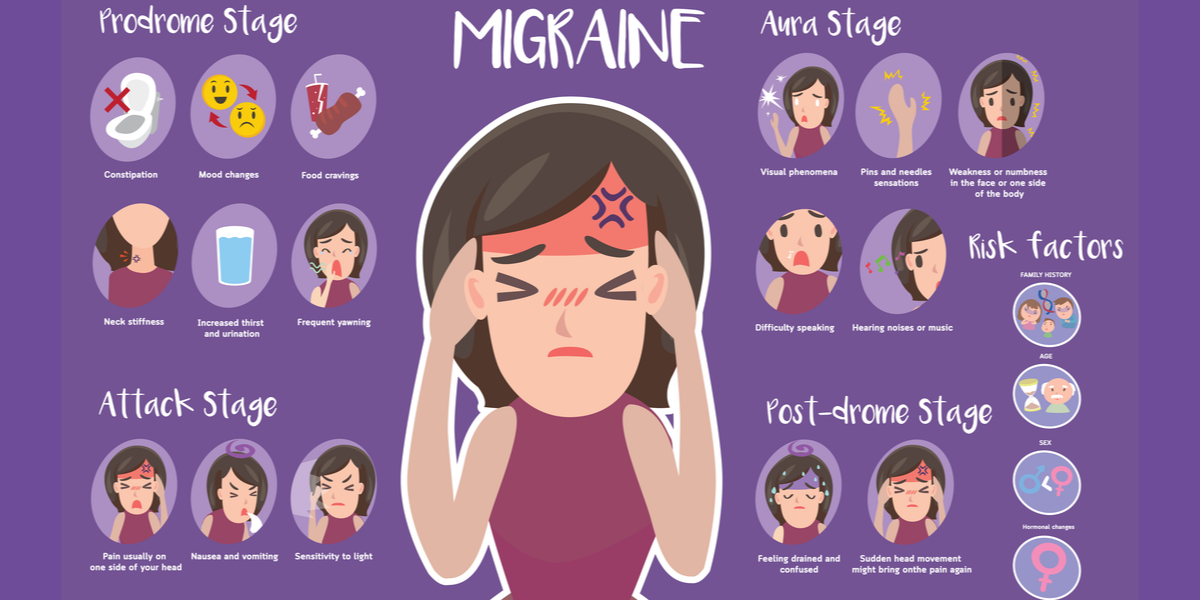
People who suffer from migraine have three different stages. During the painful phase, the headache, neck stiffness, and sensitivity to light and sounds are the most common symptoms. Other signs of a migraine include nausea, vomiting, and changes in skin color. This phase lasts from one to four hours and is associated with heightened sensitivity to sunlight and other stimuli. The pain of a migraine can be prevented with a proper diet and exercise plan.
The initial stage of a migraine is known as the sensory or pre-diabetic phase. In this stage, there may be a visual or auditory aura. The aura feels like the afterimage of a bright camera flash and may last for several minutes or an hour. If you experience these symptoms, you should seek medical help. However, this phase is relatively rare and accounts for about 70-90% of migraine episodes. Chronic migraine involves more than 15 migraine days in a month.
The sensory and motor phases last a longer time and are preceded by the migraine aura. These are neurological signs that appear before the headache even starts. They may include sudden anxiety, feeling separated from your body, and overheating. The third phase is characterized by the pain in the head. There are two types of migraine: the cerebral and the retinal type. These have similar symptoms and can last anywhere from five to 60 minutes.
If a patient is experiencing a migraine, it is important to document all of their experiences. You should note your sleep hours, stress level, and food and water intake. You should also describe the type of pain you feel, rate it on a scale of one to ten, and write down the location of the pain. You should also note the medications you’ve used for this condition. This information may be helpful for your doctor if you have a complicated case of migraine.
Although avoiding migraine triggers can be effective in reducing the frequency of migraines, it may not be enough to completely eliminate the condition. Some migraine sufferers require additional methods of control. Besides avoiding the triggers, you should make lifestyle changes to reduce your risk of developing a migraine. For example, you should be active, get plenty of sleep, and eat healthy meals. The latter will improve your body’s immune system, which is important for your overall health.
Among the various symptoms of migraine, sensory migraine is characterized by the presence of nausea and vomiting. Other symptoms include a sense of separation from the body, overheating, or feeling cold or hot. There are two main types of migraine: brainstem and retinal. For the latter type, the pain is located in the brainstem and occurs in the retina. The pain of a migraine can be very painful, so it is important to keep the occurrence of the pain as brief as possible.
In a migraine, the symptoms are usually categorized into three types: sensory and motor. The pain experienced by sufferers is often described as a dull ache, pulsating, or sharp. It may affect the entire head, one side, or even the front or back of the head. It may also affect the eye and sinuses. During the migraine, it is important to stay calm and avoid unnecessary stress.
While most of the symptoms of migraine can be avoided, a migraine sufferer should consult a medical professional to determine the exact cause. Keeping a migraine diary can help determine the cause of the headache and help prevent further episodes. Aside from logging the symptoms, the migraine sufferer should keep track of how much sleep they get and how much they stress themselves. The symptoms of a migraine are not limited to one part of the body. It is not necessary to have an extensive medical history to diagnose the cause of a migraine.
The symptoms of a migraine are categorized into two types: the sensory type involves sensations such as light, sound, and smell. The postdromal stage involves a period when the pain lasts for more than an hour. The postdromal phase can also involve weakness of the muscles and extreme thirst. A migraine is a very difficult condition to treat, but the right treatment can help reduce the severity and frequency of the headache.